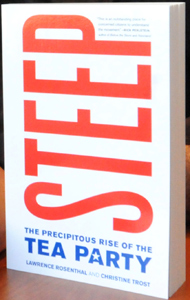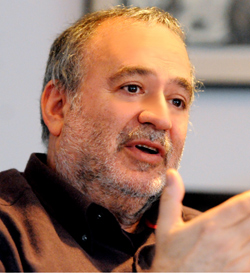The ‘Steep’ rise of the Tea Party
A new collection of scholarly essays edited by Lawrence Rosenthal, executive director of UC Berkeley's nonpartisan Center for Right-Wing Studies, and program director Christine Trost takes a hard look at the hard right.

October 1, 2012
Mitt Romney can’t be faulted, perhaps, for failing to read the tea leaves — Steep: The Precipitous Rise of the Tea Party was still in production in May, when, at a private fundraising event, he dismissed 47 percent of the country as entitlement addicts. With the campaign season entering the final stretch, though, the book’s insights into right-wing politics couldn’t be more timely. Here’s one: Tea Partiers may loathe Obamacare, but great numbers of this key Republican faction, it turns out, insist on their right to big-government programs like Medicare and Social Security
“If 50 million people who don’t have health insurance get it, that somehow jeopardizes our Medicare,” says Lawrence Rosenthal, explaining the rationale by which Tea Partiers can simultaneously love and hate federal entitlements. “It’s a zero-sum way of thinking. It’s not that the pie gets bigger, it’s that what they get is going to be taken away.”
At a now-notorious town-hall meeting in 2009, soon after the Tea Party had burst on the scene, one man angrily warned a U.S. congressman to “keep your government hands off my Medicare.” The tortuous logic of such demands is just one of the tensions examined in Steep, a new collection of scholarly essays edited by Rosenthal, executive director of UC Berkeley’s Center for Right-Wing Studies, and CRWS program director Christine Trost.
Is the Tea Party a grassroots movement, or Koch-sponsored Astroturf? At odds with cultural conservatism, or learning from its mistakes? Inheritors of a right-wing pedigree traceable to the John Birch Society, or an ad hoc reaction to a Democrat — and an African American one, at that — in the White House?
The scholars in Steep shed light on these and, if indirectly, a host of other questions that may be puzzling political junkies. Why, for example, would beneficiaries of federal programs lionize someone like Wisconsin Rep. Paul Ryan, who — until Romney tapped him to be his running mate — vowed to privatize them? And why, as avowed anti-Washington deficit hawks, would they embrace a seven-term congressman — Ryan, again — with a solid record of loyal support for the budget-busting policies of George W. Bush?
 “In a funny way, these are people who cheered the coming to power of the conservative movement in 1980, and yet have managed for 30 years, with conservatism in power, to continue to see themselves as an insurgent movement,” says Rosenthal. “They’re people who have been unhappy with Republican officeholders for the last 30 years. ”
“In a funny way, these are people who cheered the coming to power of the conservative movement in 1980, and yet have managed for 30 years, with conservatism in power, to continue to see themselves as an insurgent movement,” says Rosenthal. “They’re people who have been unhappy with Republican officeholders for the last 30 years. ”
“A key lesson of the book is to not think of the Tea Party as this separate thing, but to understand it as a core element of the Republican Party,” says Trost. “It’s really a question of the future of the Republican Party. Is the party going to be taken over by a very conservative, very active base that’s been growing over the last 30 years, or are they going to leave it and go someplace else? And if they leave, where are they going to go?”
That rocky marriage between increasingly right-leaning GOP regulars and those who have pushed them that way — what Rosenthal calls “the right of the right” — may depend on how Romney fares in November. Despite “an almost poignant” conversation in Tea Party blogs over whether to back “anybody but Obama” — even a formerly pro-choice Massachusetts governor whose legacy includes an “individual mandate” for health insurance — he says many were convinced the president would lose “because America is going to rise up and get rid of him.”
Recently, though, “There’s been a decline in that certainty and conviction that’s led to a kind of resurrected soul-searching about whether they’ve wasted their time supporting Romney,” Rosenthal says. “And there’s been a resurrection of conversation about third parties.”
A tale of two movements
Most accounts date the Tea Party’s coming-out as a national phenomenon to February 2009, when CNBC commentator Rick Santelli, speaking from the floor of the Chicago Mercantile Exchange, accused President Obama of trying to “subsidize the losers’ mortgages” by signing the Homeowners Affordability and Stability Plan. Whether by foresight or coincidence (or a combination of both), it was around that time that Trost and Rosenthal hung out the shingle for what was initially called the Center for the Comparative Study of Right-Wing Movements.

Christine Trost
The far more catchily titled new volume grew out of a 2010 conference organized at Berkeley by the center. Steep features updated essays by many of the scholars who took part, along with fresh perspectives from researchers into what remains, for academics, largely uncharted territory.
“At the time of the conference, there really was no other scholarship to critique on the Tea Party,” says Trost, who earned her Ph.D. in political science from Berkeley. “So the idea was, we need to generate some scholarship. There’s a lot of media hype on the Tea Party, but where’s the scholarship?”
“People were flailing around, trying to understand what this was,” adds Rosenthal. “Our point was to try to give it a more academically rigorous description.”
Besides adding historical context, Steep delves into the importance of class, race and gender in the movement’s rise, its relationships with the religious right and the Republican establishment and, in one chapter, the belief that demands to “keep your government hands off my Medicare” are necessarily “illiberal and intolerant.”
The author of that chapter, University of Michigan professor Lisa Disch, “argues that these folks have bought into these New Deal programs, but so well that they don’t even recognize them as such,” says Trost. “She harkens back to Franklin Roosevelt as framing them not as programs intended to address dependency — he specifically took it out of that realm, and framed it in terms of work, as a right that you get for the hours that you work. So the result is that people don’t necessarily associate it with the welfare state.”
Meanwhile, in addition to the high-profile national organizations, the shape-shifting Tea Party also includes “a very loose network of organizations at the local level that aren’t necessarily focused on national politics,” observes Trost. These local Tea Partiers are committed to “dismantling sustainability initiatives” in the Bay Area, for example, or taking control of school boards in Southern California, “very similar to what we saw with the religious right in the 1990s.”
Rosenthal, whose Berkeley doctorate is in sociology, notes how both the Tea Party and Occupy Wall Street sprang up in the wake of 2007’s financial and real-estate collapse, “the final blow of a decades-long process of diminishing potential for working, middle-class people to achieve the American Dream.”
“To some extent, both movements are reactions to that,” he says, “but one from people at the beginning of their working lives versus people at the end of their working lives who already have something. ”
Where Republicans are “running on the Tea Party line,” Rosenthal says, “Somewhere around last December, Barack Obama started talking about things like fairness, and questions of social and economic inequality, which had suddenly become apparent, in large part due to the Occupy movement.” Those issues would come to assume “a central and determinative role in what the Democratic Party is running on in the presidential campaign of 2012.”
“And so to some extent,” he adds, “the presidential campaign of 2012 is a tale of these two movements.”
As to whither the Tea Party, neither he nor Trost will hazard a guess. But Rosenthal, noting that the United States today is “a very different country than the one Ronald Reagan took over” in 1980, suggests that demographic changes and shifting attitudes on questions of race and social issues may be leaving the Tea Party — and the party it’s moved so far to the right — behind.
“Have we ever seen anything that changed as rapidly as opinions about gay marriage?” he asks. “That’s a reflection of the demographic change that’s happening. And I don’t think the Republicans have a solution for that, other than holding their breath and turning blue.
“Which is meant,” he makes clear, “as a double entendre.”
